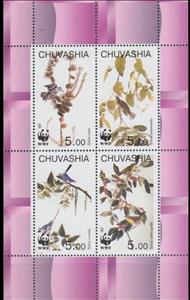Mini Sheet: Wwf (Cinderellas 1998)
Wwf (Cinderellas 1998)
01 January (Cinderellas ) within release Russia : Chuvashia goes into circulation Mini Sheet Wwf face value 4*5 Russian ruble
| Mini Sheet Wwf in catalogues | |
|---|---|
| Colnect codes: | Col: RU-CU 1998-09 |
Mini Sheet is square format.
The item was illegally manufactured without the permission of the postal administration inscribed on the stamps. There is no postage validity.Also in the issue Russia : Chuvashia:
- Mini Sheet - Animals WWF face value 4*2;
- Mini Sheet - Animals WWF face value 12*2;
- Mini Sheet - Birds WWF face value 4*5;
- Mini Sheet - Cats face value 6*5;
- Mini Sheet - Cats face value 6*5;
- Mini Sheet - Dogs face value 6*5;
- Mini Sheet - Fishes face value 6*5;
- Mini Sheet - Space rocket face value 6*5;
- Mini Sheet - Wwf face value 4*5;
|
Data entry completed
53%
|
|
|---|---|
| Mini Sheet Wwf in digits | |
| Country: | Cinderellas |
| Date: | 1998-01-01 |
| Print: | Offset lithography |
| Emission: | Cinderella |
| Format: | Mini Sheet |
| Face Value: | 4*5 Russian ruble |
Mini Sheet Wwf it reflects the thematic directions:
Animals are multicellular, eukaryotic organisms of the kingdom Animalia (also called Metazoa). All animals are motile, meaning they can move spontaneously and independently, at some point in their lives. Their body plan eventually becomes fixed as they develop, although some undergo a process of metamorphosis later on in their lives. All animals are heterotrophs: they must ingest other organisms or their products for sustenance.
Birds (Aves), a subgroup of Reptiles, are the last living examples of Dinosaurs. They are a group of endothermic vertebrates, characterised by feathers, toothless beaked jaws, the laying of hard-shelled eggs, a high metabolic rate, a four-chambered heart, and a strong yet lightweight skeleton. Birds live worldwide and range in size from the 5 cm (2 in) bee hummingbird to the 2.75 m (9 ft) ostrich. They rank as the class of tetrapods with the most living species, at approximately ten thousand, with more than half of these being passerines, sometimes known as perching birds. Birds are the closest living relatives of crocodilians.
A flower, sometimes known as a bloom or blossom, is the reproductive structure found in plants that are floral (plants of the division Magnoliophyta, also called angiosperms). The biological function of a flower is to effect reproduction, usually by providing a mechanism for the union of sperm with eggs. Flowers may facilitate outcrossing (fusion of sperm and eggs from different individuals in a population) or allow selfing (fusion of sperm and egg from the same flower). Some flowers produce diaspores without fertilization (parthenocarpy). Flowers contain sporangia and are the site where gametophytes develop. Many flowers have evolved to be attractive to animals, so as to cause them to be vectors for the transfer of pollen. After fertilization, the ovary of the flower develops into fruit containing seeds. In addition to facilitating the reproduction of flowering plants, flowers have long been admired and used by humans to beautify their environment, and also as objects of romance, ritual, religion, medicine and as a source of food.



